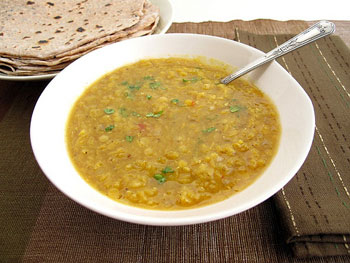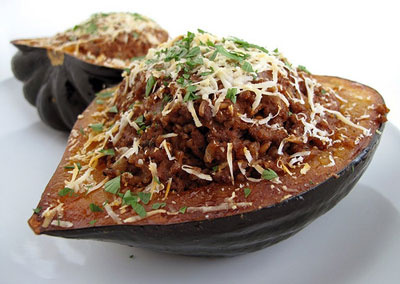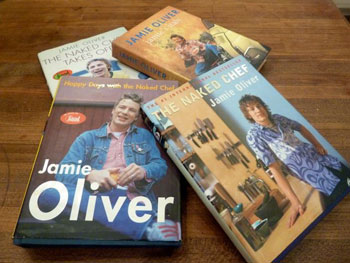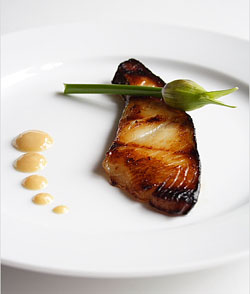 Soups and stews are my favorite dishes during the cold-weather months. Now that the weather has turned chilly and much of the past few weeks have been marked by rain, I am ready to jump into my repertoire of soups and stews. I love meals of chicken soup or beef stew, but I also enjoy vegetarian dishes that are just as filling, nutritious, and comforting. Something with a bit of heat and spice is right up there with the best of soups and stews. That dish for me is Indian dal, a cross between a soup and stew.
Soups and stews are my favorite dishes during the cold-weather months. Now that the weather has turned chilly and much of the past few weeks have been marked by rain, I am ready to jump into my repertoire of soups and stews. I love meals of chicken soup or beef stew, but I also enjoy vegetarian dishes that are just as filling, nutritious, and comforting. Something with a bit of heat and spice is right up there with the best of soups and stews. That dish for me is Indian dal, a cross between a soup and stew.
Made of legumes (specifically lentils, split peas, or chickpeas), dal is simply put a very earthy dish, often served as part of a thali, a selection of different dishes that can include poultry or meats, vegetables, chutney, raita, and breads. But even when served with rice and/or the flatbread chapati, dal can make a complete meal. The Indian spice blend, garam masala brings warmth and deep flavor and a combination of turmeric and paprika creates a glowing orange color. When you desire something comforting and thoroughly warming, this favorite Indian comfort food is the dish to make.
Global Cuisine
Global Cuisine
Noodle Diplomacy: Deconstructing the Biden Set
 I knew them so well, I am sure I could have called them by their first name or (at the very least) in our family’s preferred style – ‘Uncle’ Chiang and ‘Auntie’ Madame Chiang, but I had much too much respect for those monstrously large and patronizing portraits that hung in the Grauman’s Chinese Theater to call them anything but Generalissimo Chiang Kai-shek and Madame Chiang Kai-shek. And, I always greeted them with reverence each Friday night when we went to the Chinese Theater and to the movies! I guess I was seven, and I had never seen portraits so grand and large. I wonder what happened to them. When were they un-ceremoniously dethroned and where are they now? Probably, resting on their sides against the wall of some antique warehouse in downtown Los Angeles smelling of incense and camphor…
I knew them so well, I am sure I could have called them by their first name or (at the very least) in our family’s preferred style – ‘Uncle’ Chiang and ‘Auntie’ Madame Chiang, but I had much too much respect for those monstrously large and patronizing portraits that hung in the Grauman’s Chinese Theater to call them anything but Generalissimo Chiang Kai-shek and Madame Chiang Kai-shek. And, I always greeted them with reverence each Friday night when we went to the Chinese Theater and to the movies! I guess I was seven, and I had never seen portraits so grand and large. I wonder what happened to them. When were they un-ceremoniously dethroned and where are they now? Probably, resting on their sides against the wall of some antique warehouse in downtown Los Angeles smelling of incense and camphor…
Besides movies at the Chinese Theater, (Remember Dragon Seed with that lovely Chinese actress, Katherine Hepburn?) there were exotic dinners with my parents in Chinatown restaurants and visits afterwards to the small gift shops nearby where I fondled the porcelain dishes with green dragons, vowing one day to have plates just like them at home when I served Chinese food which I would surely learn to create.
Lebanese Lamb and Bulgur–Stuffed Acorn Squash
 I love Mediterranean food especially from the eastern region, spanning the countries from Greece through Turkey and all the way down to Lebanon and Egypt in the north of Africa. Just thinking about gyros, kebabs, and a platter of mezze from these countries makes my mouth water. It was in college that I first experienced this culinary culture, trying new things like pita bread, falafel, tabbouleh, and hummus. Then on a summer break from school I took a family trip to Hungary and was surprised by all the restaurants selling gyros and kebabs. One corner it was a restaurant owned by a Turkish and on the other corner a restaurant owned by a Greek, all selling similar foods but with different names. That's when I realized the close connection between all these countries: they were all ruled by the Ottoman Empire.
I love Mediterranean food especially from the eastern region, spanning the countries from Greece through Turkey and all the way down to Lebanon and Egypt in the north of Africa. Just thinking about gyros, kebabs, and a platter of mezze from these countries makes my mouth water. It was in college that I first experienced this culinary culture, trying new things like pita bread, falafel, tabbouleh, and hummus. Then on a summer break from school I took a family trip to Hungary and was surprised by all the restaurants selling gyros and kebabs. One corner it was a restaurant owned by a Turkish and on the other corner a restaurant owned by a Greek, all selling similar foods but with different names. That's when I realized the close connection between all these countries: they were all ruled by the Ottoman Empire.
Probably the best thing that came from the Ottoman rule was the melting pot of cuisine. One of my favorite restaurants to go for eastern Mediterranean slash Middle Eastern food is Kashkaval in New York City. I really can't tell which country their food represents, but they have everything on the menu from Hungarain chicken paprikash to Turkish meatballs. Their enormous selection of mezze are a feature of the menu and so are their fondues. The one made from Kashkaval cheese, the source for the restaurant's names, is unbeatably good. A vegetarian coworker first introduced me to the restaurant and I've returned countless times ever since always with friends in tow. It's the type of good food that encourages sharing among everyone.
Quick & Easy Steak with Mushrooms and Bok Choy
 If you have as many chef crushes as I do, here’s some good news: you don’t have to break up with your favorite chefs in order to lose weight, you just have to redefine your relationships…
If you have as many chef crushes as I do, here’s some good news: you don’t have to break up with your favorite chefs in order to lose weight, you just have to redefine your relationships…
And here’s a Jamie Oliver “recipe re-do” to prove the point: Skinny Steak with Mushrooms, Bok Choy and Gingered Tamari Sauce.
From the moment Jamie burst on the scene–with dishes that were both simple and sophisticated, and a style of cooking that was casual and fun–I was a fan; never questioning his recipes, I just cooked. But now, 30+ pounds lighter and with an eye on the health of everyone in my family, I do question the ingredients and instructions for every recipe I make and, though I still adore Jamie and his dishes, I happily alter them.
Found in Happy Days with the Naked Chef, the original version of this quick and easy recipe calls for one 8-ounce sirloin steak per person. Without getting into the other health risks of eating too much red meat, it’s just an awful lot of fat and calories…32 grams of fat, to be exact, and roughly 500 calories–about a third of the calories I need in an entire day… And I’m not talking about the fat and calories in the whole meal, just the portion of the plate that’s protein!
By reducing that super-sized portion of beef and using meat-mimicking magic mushrooms to fill out the plate you can still enjoy the taste and sensation of a beef dinner but with half the fat, cholesterol and calories.
Chaparang!
 Before I tell you this story, I have to tell you how I met Bobby in the first place. I was in Century City with a friend of mine and we ran into this group of Persian guys. It was all very high school and they were all very hung over. I wasn’t really paying much attention until one of them, within two minutes of having been introduced to me, starting feeling up my arm. I mean, really, feeling up my arm—you know, the underneath part of the upper arm that so many women (and some men) are sensitive about? Yea. To make matters worse, every time I tried to pull away he’d respond by saying, “Give me that filet.” “Excuse me?!?” “You ate a lot of hoomoos as a kid, didn’t you?” “Are you saying I’m fat?!” “Don’t insult the filet this way.”
Before I tell you this story, I have to tell you how I met Bobby in the first place. I was in Century City with a friend of mine and we ran into this group of Persian guys. It was all very high school and they were all very hung over. I wasn’t really paying much attention until one of them, within two minutes of having been introduced to me, starting feeling up my arm. I mean, really, feeling up my arm—you know, the underneath part of the upper arm that so many women (and some men) are sensitive about? Yea. To make matters worse, every time I tried to pull away he’d respond by saying, “Give me that filet.” “Excuse me?!?” “You ate a lot of hoomoos as a kid, didn’t you?” “Are you saying I’m fat?!” “Don’t insult the filet this way.”
I didn’t see Bobby again for a few months and had pretty much forgotten about the whole exchange when I was at a birthday party at the new-ish Trader Vic’s and all of a sudden, from across the pool, I hear, “Filet . . . Can it be you?” Needless to say, Bobby and I became fast friends, although he does still try to feel up my arm occasionally.
More Articles ...
Welcome to the new One for the Table ...
Our Home Page will be different each time you arrive.
We're sure you'll find something to pique your interest...


